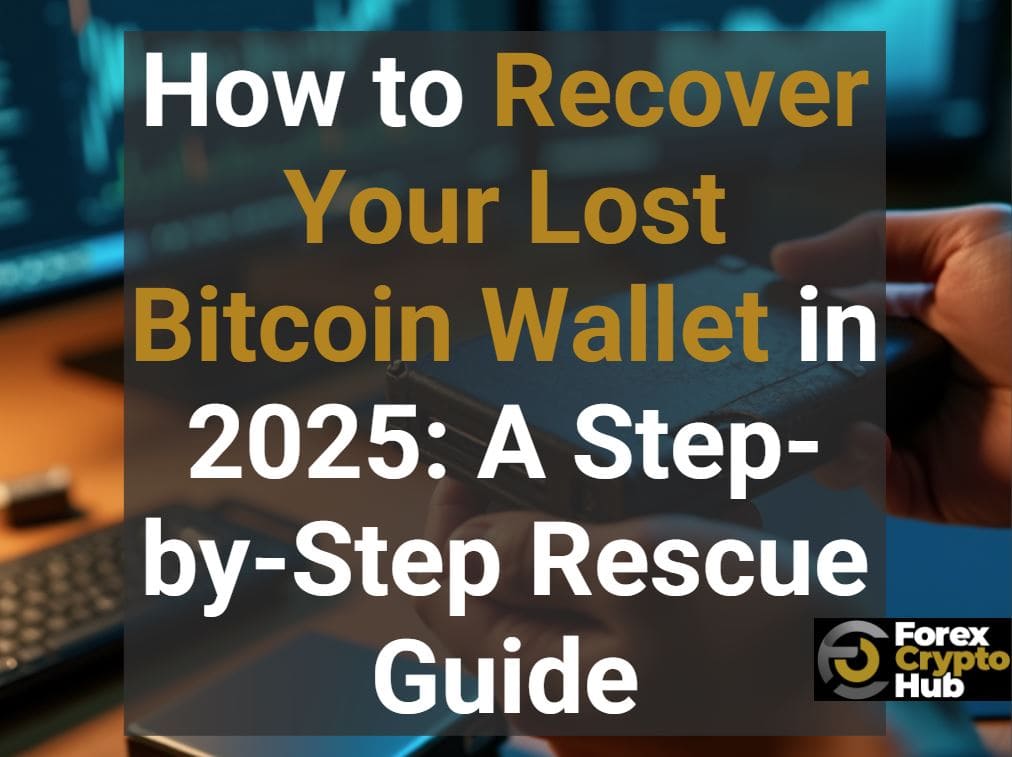$100 billion in Bitcoin remains locked away and might be lost forever. The numbers are shocking – 3.8 million BTC, about 29% of all circulating Bitcoin, could be permanently inaccessible.
Many crypto owners know that gut-wrenching feeling when they realize their digital fortune is beyond reach. Stefan Thomas couldn’t access his 7,002 BTC worth over $235 million. James Howells accidentally threw away a hard drive that held 8,000 BTC.
The situation isn’t completely hopeless. Recent studies reveal 2.5% of lost Bitcoin valued at $5.8 billion could still be recovered. Your digital assets might be retrievable whether you misplaced your seed phrase, forgot your password, or can’t access your hardware wallet. We’ll walk you through all possible recovery methods.
Let’s explore your options and start your Bitcoin wallet recovery process together.
Understanding Bitcoin Wallet Loss in 2025
Bitcoin users in 2025 still can’t get into their wallets. Millions face money problems because they lost their keys or forgot passwords. You need to know why and how wallets become locked to prevent losses or get them back.
Common causes of lost bitcoin wallets
People lose their Bitcoin wallets in several ways in 2025. Most users simply forget their passwords. They know where their money is but can’t reach it. This basic mistake locks away much of the inaccessible Bitcoin.
Lost private keys are another big reason wallets get locked. You can’t get your Bitcoin without these vital credentials – once they’re gone, your money might be lost forever. James Howells learned this the hard way. He threw away a hard drive in 2013 that had keys to 8,000 bitcoins, now worth hundreds of millions of dollars.
Other common reasons include:
- Hard drives fail about 1.54% each year
- People delete wallet files or write over important data by mistake
- Hackers break in through malware and phishing scams
- Wallet companies go bankrupt, like Mt. Gox did in 2014, losing about 850,000 BTC
- Bitcoin gets sent to wrong addresses with no way to reverse it
Most losses happen because people don’t realize what it means to own cryptocurrency. Bitcoin gives you freedom but nobody can help if you lose access – unlike regular banks.
The scale of lost cryptocurrency in 2025
Bitcoin losses hit record levels in 2025. Chainalysis says about 20% of all Bitcoin—around 3.79 million BTC—is gone because of forgotten passwords and lost private keys. Unchained Capital’s 2023 report shows up to 3.8 million bitcoins are lost, about 19% of what exists today.
People can’t use more than $100 billion worth of Bitcoin anymore. IntoTheBlock’s numbers look worse—about 29% of all Bitcoin might be gone forever, stuck in accounts nobody has touched for over five years.
These losses change how much Bitcoin people can actually use. Bitcoin has a limit of 21 million coins, but only 19-20 million BTC are really out there. If Satoshi Nakamoto’s million bitcoin stay untouched, only 18 million BTC might ever be used.
This lack of coins makes each remaining bitcoin worth more. Crime with cryptocurrency keeps growing too. Chainalysis found that bad actors received about $40.90 billion in 2024, which could reach $51 billion based on past patterns.
Types of wallets and their recovery challenges
Different wallets in 2025 come with their own recovery problems:
Hot wallets work through software connected to the internet. They’re easy to use but hackers can break in. You might get them back if you have backups. A seed phrase makes recovery simple, but malware and hacking are real risks.
Cold wallets stay offline, and hardware wallets keep your money safest. These physical devices protect private keys better by keeping them isolated, but recovery gets tough if you damage or lose them without backup. Ledger wallets store private keys in special chips that resist physical attacks.
Custodial wallets let companies hold your assets. Getting them back means working with support teams and proving who you are. But if the company fails—like FTX did in 2022—you might never see your money again.
Paper wallets keep your money safe from online threats but water or fire can destroy them easily. You can only get your money back if the printed private keys survive.
The best way to recover any wallet depends on your backup method. Without seed phrases or private key copies, most wallets lock forever. That’s why stopping losses works better than trying to fix them later.
Assessing Your Lost Bitcoin Wallet Situation
Getting your lost Bitcoin wallet back requires a full picture of your situation. Your wallet type and available information determine the recovery path. A structured way can significantly boost your chances of successful recovery.
Identifying your wallet type
Finding out exactly what type of wallet you used is crucial to recovering your Bitcoin. Bitcoin wallets come in four main categories, each needing different recovery methods:
Software wallets store your Bitcoin on a computer or mobile device. Look for wallet.dat files on your hard drives, or check your app download history on mobile devices. These include hot wallets that connect to the internet and desktop applications that manage your private keys locally.
Hardware wallets like Ledger or Trezor keep your private keys on physical devices separate from internet-connected computers. When you bought such a device, you likely got a card to record your seed phrase during setup.
Custodial wallets come from exchanges like Coinbase or Binance. Check your email history for registration confirmations or login credentials from these platforms. With these services, you should contact customer support first.
Paper wallets use printed private keys or QR codes. These aren’t common in 2025 but early Bitcoin adopters used them often. If you had one, look for any printed documents you might have kept in secure places.
Gathering available information
After identifying your wallet type, gather everything that might help:
Seed phrases: Also called recovery phrases or mnemonic phrases, these consist of 12, 18, or 24 words that can restore your entire wallet. Look through physical notebooks, safety deposit boxes, fireproof safes, or metal backup devices.
Private keys: Older wallet versions might have used individual private keys instead of seed phrases. Check digital backups, USB drives, or CD-ROMs that could have this information.
Wallet software details: Figure out which wallet application you used (Bitcoin Core, Exodus, etc.) since some recovery methods work only with specific software.
Transaction history: If you remember making transactions, look through email receipts or bank statements related to cryptocurrency purchases.
Password hints: For encrypted wallets, collect any notes or patterns you typically used for passwords.
The device that might have wallet files should not be used to prevent overwriting valuable data. Studies show 30-40% of recoverable cases involve old laptops with hard drive issues. Users often make recovery harder by reformatting devices or reinstalling wallets.
Estimating recovery chances
Knowing your recovery odds helps set realistic expectations:
Research shows approximately 2.45% of all lost Bitcoin could be recovered. Based on Chainalysis’ estimates, this means between 68,110 and 92,855 Bitcoin can be recovered.
Your chances of recovery mainly depend on your situation:
High recovery probability (70-90%):
- You have your seed phrase or private keys
- You’re working with an active exchange
- You have the encrypted wallet file and remember password patterns
Moderate recovery probability (30-60%):
- You have the device with wallet files but no seed phrase
- You know parts of your seed phrase (some words or order)
- You can access your hardware wallet but forgot the PIN
Low recovery probability (<5%):
- Physical device was destroyed or formatted multiple times
- No backup exists for private keys or seed phrase
- Hardware wallet is damaged with no seed phrase backup
Many successful wallet recoveries happen when people find old hard drives or storage media they thought were gone. Search all possible storage spots thoroughly before assuming your Bitcoin is lost forever.
Your specific situation should guide your recovery strategy. Each wallet type needs its own approach to maximize your chances of getting back into your digital assets.
Recovering a Software Wallet with Seed Phrase
A seed phrase offers the quickest way to get back into a lost software wallet. These phrases are the foundations of generating all your wallet’s private keys and addresses, which makes them vital for Bitcoin recovery.
Locating your seed phrase backup
Your seed phrase contains 12, 18, or 24 random words that were created with your wallet. Finding this phrase should be your main goal. The core team behind most wallets strongly advises users to write down their seed phrase and keep it safe offline.
Look in these common storage spots:
- Physical paper records – Search notebooks, specially designed wallet backup cards, or laminated paper copies
- Metal backups – Some users put their seed phrases on metal plates to protect against fire and water
- Secondary properties – Look through vacation homes or other properties where you keep important documents
- Safe deposit boxes – Many people keep seed phrases in bank vaults or personal safes
You should have written down your seed phrase right after creating your wallet. If you saved it digitally (not recommended), look through encrypted drives or password managers, but this method has serious security risks.
Selecting the right wallet software
After finding your seed phrase, you’ll need the right wallet software to recover your funds:
Identify your original wallet type – Seed phrases work best with the software that created them. Check your email confirmations or app download history to find what you used before.
Choose compatible alternatives – If you can’t use your original wallet, pick one that supports the same seed phrase standard. Most reliable wallets support the BIP39 standard, which is how most seed phrases are formatted.
Verify compatibility – The wallet must support:
- Your seed phrase length (12/24 words)
- Your cryptocurrencies
- Your original wallet’s BIP standard
Bitcoin Core, Trust Wallet, and Exodus work well for recovery, but compatibility depends on your specific case.
Step-by-step restoration process
You need to be precise and careful when recovering your wallet:
Download and install the official version of your chosen wallet software
Select recovery option – Pick “restore,” “recover,” or “import existing wallet” instead of making a new one
Enter your seed phrase – Type all words exactly as they appeared originally
- Check your spelling carefully
- Keep the words in the right order
- Some wallets check each word as you type
Add additional security when prompted:
- Set up a new wallet password
- Turn on two-factor authentication if available
Synchronization period – Let the wallet sync with the blockchain. This could take minutes or hours depending on the blockchain’s size
Verify recovery success – Your balance will show up after syncing if you entered the seed phrase correctly
Blockchain.com wallet users can visit blockchain.info/wallet/forgot-password for legacy mnemonic recovery.
If you see “Unknown word” or “Invalid Checksum” errors, check your phrase against the wallet’s word list. These errors usually mean wrong words or incorrect order.
Note that legitimate recovery services will never ask for your seed phrase. Keep it private even during recovery since anyone with your phrase can access your funds.
After a successful recovery, you might want to create a new wallet with a fresh seed phrase and move your funds there, especially if someone might have seen your original phrase.
How to Recover Bitcoin Wallet Without Seed Phrase
Lost your seed phrase? Don’t panic – you still have options. Bitcoin holders can try several ways to get their funds back. Your wallet files might still exist on your devices, just waiting to be found with the right tools and some detective work.
Searching for wallet.dat files
The wallet.dat file is your digital vault that holds the vital private keys to access your Bitcoin. You’ll need to find this file as your first step to recovery.
Bitcoin Core and similar wallets usually store the wallet.dat file in these locations:
- Windows: C:\Users\Username\AppData\Roaming\Bitcoin
- Mac: ~/Library/Application Support/Bitcoin
- Linux: ~/.bitcoin
Use your system’s search function to look for wallet.dat files on all your storage devices. Look through external hard drives, USB sticks, old computers, and backup drives that might have this important file. Check your cloud backups and email attachments too – you might have stored wallet information there.
Using data recovery software
You can often get back accidentally deleted wallet files with special software. Files stay on your storage until new data writes over them.
Here are some reliable recovery tools:
- Recuva – Makes it easy to recover deleted files from hard drives, memory cards, and USB sticks.
- Puran File Recovery – Helps you get back deleted or lost files and partitions.
- TestDisk – Works great for Mac users and can recover lost partitions and fix non-booting disks.
After finding a wallet.dat file, follow these steps:
- Close all wallet applications
- Find the current wallet.dat file in your wallet program folder
- Rename the existing file (e.g., wallet.dat.old)
- Copy your recovered wallet.dat to the program folder
- Restart the wallet application and let it sync fully
Move your funds to a new secure wallet right after you regain access.
Password cracking methods for encrypted wallets
Forgotten your encrypted wallet’s password? Try these approaches:
Password recovery software: Bitcoin Password by Thegrideon and hashcat are tools that test millions of password combinations. They can create variations based on your usual password patterns to narrow down the possibilities.
Memory techniques: Before trying technical solutions, try these memory tricks:
- List your common password patterns from that time
- Look through password managers or saved browser passwords
- Check old notes from when you set up the wallet
Professional recovery services: Large Bitcoin holdings might justify hiring professionals. Companies like Gillware and DriveSavers know their stuff when it comes to crypto recovery. They’ve helped recover millions in Bitcoin using advanced methods beyond regular tools.
A legitimate recovery service will always:
- Never ask for your seed phrase
- Call to verify your identity
- Only charge fees after successful recovery
Modern wallets are harder to crack thanks to better encryption. Bitcoin Core wallets use 50,000-300,000 SHA-512 iterations per password attempt, which makes brute-force attempts slow even with powerful hardware.
If these methods don’t work, check if you used an exchange or custodial wallet – they need different recovery approaches.
Restoring Hardware Wallet Access
Hardware wallets work like fortresses for your Bitcoin, but these secure devices can get locked out, damaged, or lost. The good news is that manufacturers have built strong recovery systems to help you get back your funds safely.
Recovery options for Ledger devices
Ledger devices keep your cryptocurrencies safe by isolating private keys in a special chip. You have several reliable ways to restore access with Ledger:
The best and safest recovery method lets you use your 24-word recovery phrase with a new or reset device. Here’s what you need to do:
- Set up your Ledger device and select “Restore from recovery phrase”
- Choose your recovery phrase length (typically 24 words for Ledger)
- Enter each word in correct order using device controls
- Create a new PIN to secure access
Ledger boosts protection with their “Ledger Recover” service, an ID-based key recovery option that backs up your Secret Recovery Phrase. This extra layer helps you restore private keys after identity verification through Ledger Live. You’ll have peace of mind if your physical recovery phrase becomes unavailable.
When your Ledger device fails and you need quick access, you can temporarily import your recovery phrase into a compatible third-party wallet. In spite of that, this method brings higher security risks. Use it only as a short-term fix until you get a new hardware device.
Trezor wallet restoration process
Trezor hardware wallets use standard recovery steps that differ slightly between models. The Trezor Model One recovery works this way:
Start by selecting “Recover wallet” during device setup after connecting to Trezor Suite. You can choose between “Standard recovery” or “Advanced recovery” options. With standard recovery, you’ll enter seed words in the specific order displayed on your Trezor – not necessarily in sequential order.
Trezor Safe models (Safe 3 and Safe 5) handle recovery mainly on the device. The Safe 5’s touchscreen input makes things easier by letting you type recovery words directly. Whatever model you have, all Trezor devices ask for the right number of words from your wallet backup (usually 24 words for earlier models, 20 words for Safe 5).
You’ll need to do a factory reset first if you’ve forgotten your PIN or want to load a different wallet backup. This erases all private data including your current wallet information and lets you start a clean recovery process.
What to do if your hardware is damaged
A damaged hardware wallet doesn’t mean your Bitcoin is gone forever. Hardware wallets use standard recovery methods (typically BIP39/BIP44), so your funds stay available through other means:
The safest way is to buy a replacement hardware wallet (same brand or compatible alternative) and use your seed phrase during setup. Your new device will create all private keys again and restore full access to your funds.
When you need immediate access in emergencies, you can temporarily use your recovery phrase with a trusted software wallet. MyEtherWallet, Electrum, or Exodus are popular choices, but this should be a short-term solution only. Keep in mind that typing your seed phrase on an internet-connected device makes it much riskier.
Professional recovery services might be your last resort if your device is badly damaged and you don’t have a recovery phrase. These experts can sometimes rescue data from physically damaged hardware, but success depends on how severe the damage is.
Your cryptocurrencies live on the blockchain, not on the device itself. The hardware wallet just stores the keys you need to access them. With your recovery phrase safe, a damaged or lost device becomes just an inconvenience instead of a financial disaster.
Recovering Exchange and Custodial Wallets
Custodial wallets managed by exchanges provide a different path to recovery than self-custody options when you lose access. These services hold your private keys, so getting back control means working with their support teams rather than finding technical fixes.
Working with exchange support teams
Major cryptocurrency exchanges require users to follow specific complaint processes before exploring other recovery options. Coinbase users accept certain terms when creating accounts that require them to submit complaint forms and wait for responses. Most big platforms follow similar procedures.
These steps will improve your recovery chances:
- Keep records of all exchange communications including emails, chat logs, and support tickets to show a clear timeline
- Contact them through email, phone, and social media at the same time while staying polite but firm
- Include specific transaction IDs, timestamps, and wallet addresses in every message
Exchange recovery works much like traditional banks. They can reset your access and check your identity, which makes the process easier than non-custodial options.
Identity verification requirements
Identity verification (KYC) is the life-blood of exchange wallet recovery. This step helps protect services from illegal activities, proves real ownership, and meets regulatory requirements.
You’ll need these items ready for identity checks:
- Government-issued photo ID
- Recent proof of address from the last 3 months
- Face scan through live biometric verification
- Documents showing where funds came from for larger accounts
This information helps exchanges verify you own the account. Many platforms use advanced biometric systems that match your face against official documents and create secure links between your appearance and paperwork.
Legal options when exchanges are unresponsive
Legal paths exist when exchanges don’t respond well enough. Your user agreement outlines the rules between you and the exchange, so check it before taking legal action. These documents spell out arbitration requirements, applicable state laws, and where you can file cases.
Think over these points before legal action:
- User agreements often state the winning party gets attorney fees paid, which creates risk if you lose
- Your agreement might require arbitration, which could limit class action suits
- Exchanges often respond faster after receiving legal notices
Filing complaints with the Securities and Exchange Commission might pressure unresponsive exchanges to solve your case.
Professional Bitcoin Recovery Services
Professional recovery services offer both chances and risks in the world of lost cryptocurrency. Cryptocurrency scams cost victims between $1 billion to $14 billion in 2021 alone. Bitcoin owners with wallet access issues must know who to trust and the right time to seek help.
The Right Time to Ask for Professional Help
You should think about expert help when DIY methods fail and you have substantial funds at stake. Expert help makes sense if you face:
- Hardware failures or physically damaged devices with wallet files
- Encrypted wallets where you partly remember password patterns
- Data corruption in wallet.dat files
- Cases that need specialized forensic blockchain tools
Legitimate recovery experts know cryptocurrency recovery techniques and cybersecurity practices inside out. These specialists can tell you exactly what’s possible with your case and set the right expectations.
How to Spot Legitimate Recovery Services
Here’s what you should look for to find trustworthy recovery providers:
Start by checking their business history and reputation. Companies like Datarecovery.com have been around since cryptocurrency’s early days. Their payment structure matters too – reliable services charge fees only after successful recovery instead of asking for money upfront.
Good companies keep their pricing clear and simple. Most charge between 8-18% based on wallet value. They should also have real contact details with physical business addresses and professional ways to reach them.
Spotting Recovery Scams in 2025
Problems are systemic as most cryptocurrency recovery services turn out to be scams that target victims twice. You should watch out for these red flags:
- They ask for money before starting work
- They claim to have “special access” to crypto exchanges or hacking abilities
- They want your seed phrase, passphrase or other sensitive details
- They only talk through messaging apps like Telegram
- They promise to get back stolen funds that have already left your wallet
It’s worth mentioning that legitimate services only help you access cryptocurrency you still own, like getting private keys from damaged drives. Stolen funds are best handled by law enforcement agencies rather than recovery services.
Advanced Recovery Techniques for Lost Bitcoin
Bitcoin owners can now tap into state-of-the-art techniques to recover assets they thought were lost forever. These advanced approaches utilize the latest technology and psychological methods to access wallets that might otherwise stay locked away permanently.
Blockchain forensics tools
Blockchain forensics platforms provide powerful capabilities to deal with complex wallet losses. Tools like Elliptic Investigator let users run cross-chain crypto investigations and create single-click visualizations that track fund movements across multiple blockchains. These sophisticated systems can follow crypto assets through countless transaction hops and end up identifying source and destination points. The tools create up-to-the-minute network visualizations that show connections between wallets, transactions, and potentially illicit activities. Many platforms now automatically detect specific transaction patterns—like peeling chains or mixer-first funding—which makes them valuable in complex recovery scenarios. These tools can map related addresses retrospectively if you have known transaction histories, which might reveal access points you hadn’t thought about.
AI-assisted password recovery
AI has boosted password recovery efforts dramatically. Modern AI models like PASS-GPT—based on OpenAI’s GPT-2 architecture—are 20% better at password-guessing than previous systems. These sophisticated algorithms use progressive sampling to generate passwords one character at a time and identify patterns even in complex credentials. AI analyzes partial password information along with your typical password habits to narrow down millions of possibilities. The systems can even find new undetected patterns in your password history and might unlock wallets where traditional brute-force methods would fail.
Memory techniques for recalling forgotten information
Your own memory often holds the key to recovery. The process starts in a calm environment—close your eyes and take deep breaths before you try to recall wallet information. Visualization techniques help you mentally picture where and when you created the wallet. Association methods link forgotten information with familiar details from that same time period. Your memory of other events from the day you created your wallet might trigger recall of password elements. Breaking complex passwords into manageable segments through chunking helps recover partial credentials.
Conclusion
Bitcoin wallet recovery takes patience, a step-by-step approach, and expert knowledge. Different wallet types just need their own recovery methods – from basic seed phrase restoration to advanced AI-assisted password cracking. Your chances of success largely depend on your available information and backup methods used before the loss.
Bitcoin owners facing access problems now have more hope with new recovery options. Professional services, blockchain forensics tools, and AI-powered solutions can now achieve what seemed impossible before. Your recovery chances improve significantly when you properly document all wallet-related information.
Smart Bitcoin owners should focus on prevention through resilient backup systems. They need to keep seed phrases safe, maintain encrypted wallet file copies, and document everything about wallet creation. It’s worth mentioning that about $5.8 billion worth of lost Bitcoin could be recovered – your wallet might be among them.
You can begin your recovery experience today. Assess your situation carefully and work through each possible solution methodically. The steps in this piece will guide you to potentially recover your valuable digital assets.
FAQs
Q1. Is it possible to recover a lost Bitcoin wallet? Yes, it’s possible to recover a lost Bitcoin wallet in many cases. The recovery method depends on the type of wallet and what information you still have available. For software wallets, having your seed phrase is the easiest way to restore access. For hardware wallets, you can use the recovery phrase with a new device. Even without a seed phrase, there may be options like searching for wallet files or using data recovery software.
Q2. What should I do if I’ve forgotten my Bitcoin wallet password? If you’ve forgotten your Bitcoin wallet password, don’t panic. First, try to recall any password patterns you commonly use. You can also attempt memory techniques to jog your recollection. For encrypted wallets, specialized password recovery software exists that can test millions of combinations. As a last resort, professional recovery services may be able to help crack the encryption, especially if you remember parts of the password.
Q3. Can I recover Bitcoin from an old wallet address? Recovering Bitcoin from an old wallet address is possible if you have the private keys or seed phrase associated with that address. If you’ve lost access to the wallet itself, you’ll need to focus on recovering the wallet rather than the specific address. Keep in mind that cryptocurrency transactions are irreversible, so if you’ve sent Bitcoin to an unknown address, recovery may not be possible.
Q4. Are there professional services that can help recover lost Bitcoin? Yes, there are professional Bitcoin recovery services available. These specialists use advanced techniques and tools to recover lost wallets in situations where DIY methods have failed. However, it’s crucial to thoroughly vet any service before engaging them, as the field is rife with scams. Legitimate services typically charge a percentage fee only upon successful recovery and never ask for your seed phrase upfront.
Q5. How can I prevent losing access to my Bitcoin wallet in the future? To prevent future wallet loss, implement robust security practices. Store your seed phrase in multiple secure locations, use strong passwords, and enable two-factor authentication where possible. Regularly back up your wallet and keep software updated. Consider using hardware wallets for large holdings. Most importantly, educate yourself on wallet security best practices and stay informed about the latest threats and protection methods in the cryptocurrency space.




